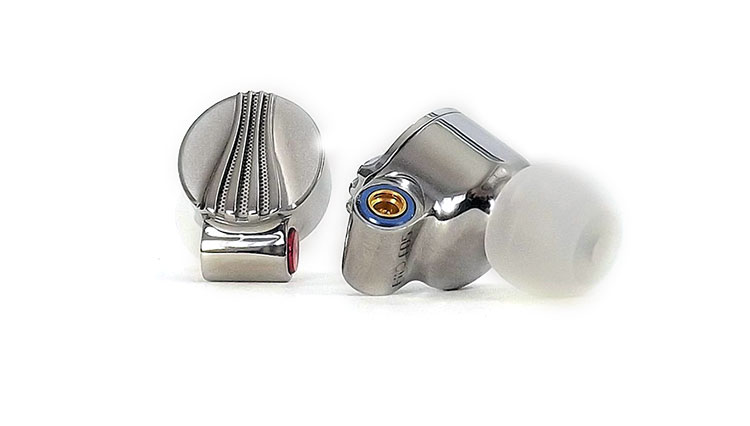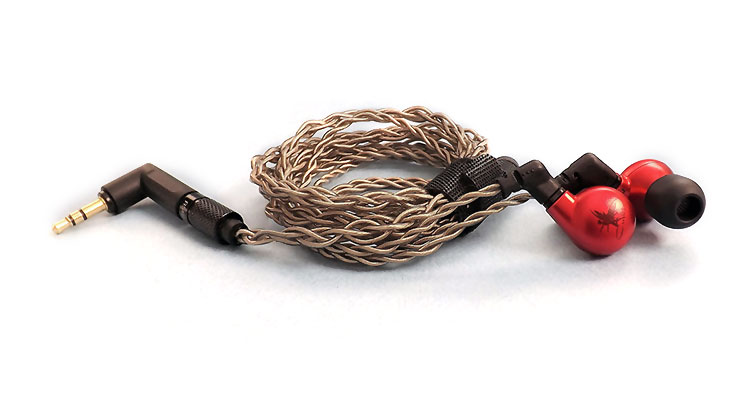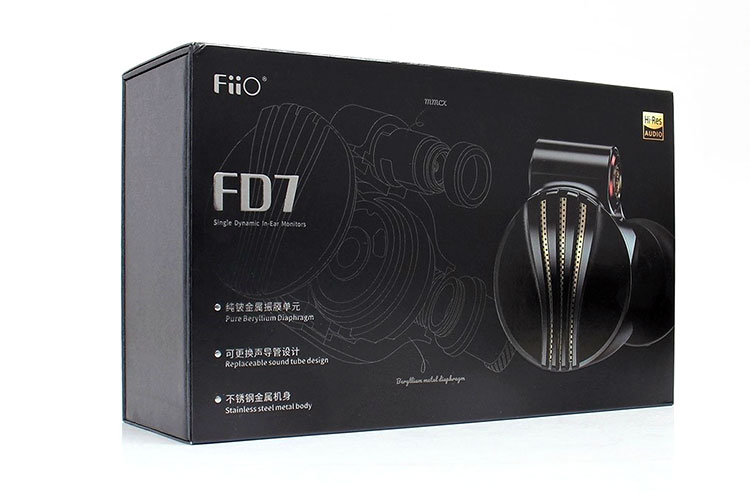Synergy
Interchangeable Sound Tubes
FiiO includes 3 sets of output tubes which specifically change the overall sound tuning but to be honest I stuck with the balanced set most of the time because I liked them the most. My second choice was the wide soundstage tube.
The ones I did not like much were the narrow bass tubes because they over-emphasized and muddied the bass response plus the fact that the tube was narrow and you are restricted to exclusively use the two white silicon triple flange tips which some people dislike. If you install any other tip they will fall off too easily and probably stay lodged inside the ear canal.
The opposite happened with the FD5 and the narrow tube sound-wise. Although the same problem occurred with the regular tips not fitting and falling off the sound was widened on the FD5 but not with the FD7. In fact, on the FD7 they made them sound on the narrow side to me.
The large inner tubes were my second choice and did improve the soundstage by widening the panorama but the bass was somewhat centralized and lost firmness plus lost some bass presence.
Efficiency
The FiiO FD7 works well with low power equipment just fine, is very efficient and you might get by with just a phone. However, to get the most out of the FD7 I would say to use a decent powered Micro DAC dongle minimum because it deserves some good clean power with a resolving DAC.
The FiiO FD7 IEMs are not hissers thankfully. You could use them on high-power equipment and not get hiss. My personal opinion is that BA drivers have a higher propensity to hissing compared to dynamic drivers.
Pairings
To set an example for the above statements, I used the FD7 on a ZEN CAN and on the 4.4mm output and it safely took the 18 decibel gain and did just fine with the 1890mW per side that this amplifier has available and with no audible hiss to boot. It even took my A90 connected to the balanced side just fine and actually sounded fantastic on both amps.
I sometimes giggle however at the manufacturer’s maximum power rating and here is another case, no offense to FiiO. The specification listed claims a max input power of 100mW and I think you could safely add another zero to that number for sure.
Select Comparisons
FiiO FD5
$329.00
Technical
I bet most readers have had this question in mind since the introduction of the review. These two IEMs have a contrasting concept to me although they have so many similarities like the almost identical shells and even the accessory inclusion and packaging.
Although there is the mention of Beryllium on the dynamic driver inside the FD5 it’s only a coating on DLC and not a pure Beryllium cone. There lies the reason why the FD7 IEM costs about double the price. Beryllium is very expensive to work with.
Design
The same shell design is carried over to the FD7 from the FD5 but the 5 had a more industrial-looking design due to the color scheme. Weight and comfort were identical basically.
They both share similar cable designs but the FD5 cable uses silver-coated OFC wire while the FD7 uses pure silver wires. They both come with the same FABRILOUS tip system, the same 3.5mm TRS, 2.5 balanced, and 4.4mm balanced plugs.
They also come with the same storage case, cleaning brush, and MMCX removal tool but the FD7 comes with an extra sound tube and a higher tip count.
Performance
To me, both these IEMs have different sound signatures and conceptually aim for a different signature. The FD5 is more bass-centric while the FD7 is more balanced and better at details.
The bass response on the FD5 has a slower low bass roll-off while the FD7 has a sharper drop. It seems the FD5 can go deeper and have slightly more bass impactfulness plus they can handle a heavier bass boost. This is where the winning points for the FD5 stop, however.
For example, the FD7 midrange is smoother, more precise, and tonally more pleasing not to mention the high frequencies. When I reviewed the FD5 I did mention their weakest point was the high frequencies.
The FD7 produces clean, sharp highs with the absence of grain and extends very well. Although the FD5 produces fairly clean highs, the top-end extension is not as good as on the FD7.
Little Dot CU KIS
$719.00
Technical
I have no idea why people do not speak more often about these flagship IEMs which design and their deep red color look good enough to eat.
The CU KIS IEMs use a 2+2 driver configuration. Two 10mm dynamic ADLC drivers back-to-back in a four-channel twin cavity module plus two customized BA drivers in a single housing are combined with a two-way crossover.
Connectivity is the .78mm type and Little Dot uses their patented sleeve system on their connectors which gives the plug longevity beyond regular connectors.
Design
These Anodic-Oxidation coated IEMs are absolutely gorgeous. I would also keep them away from small children because they look like candy and they might try to eat them.
The CU KIS has a rather unique shape and finish. The inside of the shells has what Little Dot calls a multilayer looping structure which I can only describe as a mini-Labyrinth system that was designed to remove internal resonances and at the same time tune bass response.
The stock cable on the CU KIS has more connectivity which includes the 3.5mm balanced that is missing on the FD7 set but three of the four are adapters that extend the length of the plug. I do much prefer the swappable plugs found on the FiiO set.
Performance
Speaking of bass, the CU KIS are heavy hitters and even more so considering they can take a large boost with a minimum amount of distortion. The bass tuning is more forward and they seem to dig deeper down low but not by much.
Actually, everything about the CU KIS sound signature is slightly more forward-oriented. Some people dislike forwardness but if you show restraint with the CU KIS and use the right amplifier they perform very well because of their high ability to resolve and present detail.
The midbass response is upfront and the bass seems to have more presence and so does the midrange as it’s pushed forward and closer into the listener. High frequencies in output are rather balanced but the FD7 highs have more clarity and resolve up top.
The CU KIS needs more power to go for sure. I was highly surprised at the results when I hooked them up to the 4.4mm balanced out on that same ZEN CAN. I started at the 0 decibel gain and realized volume was way too low so I pushed it with the full 18 decibel gain and that’s when they fell into place far as loudness is concerned.
Kinera Imperial Skuld
$550.00
Technical
There is always another road one could take. This IEM has a totally contrasting design, absence of dynamic drivers, and a different sound signature. Conceptually, the Kinera Imperial Skuld is a totally different concept from the FD7 on all fronts.
The Skuld aims for a flat frequency and neutral response from the five Balanced Armature drivers. Actually, if you count the two double BA drivers as individual drivers then there would be a total count of seven drivers inside each one of those shells.
Design
Again, not only is there a contrast in driver configuration but also in the shell construction. The Imperial Skuld has resin shells, are hand-assembled and artfully decorated which is totally opposite from the FD7 all-metal construction.
The Kinera Imperial Skuld comes with a really nice cable with an 8-core braid but the different connectors are short extension wires which I do like more compared to the adapter type which creates a long lever facilitating breakage especially in a portable scenario.
Performance
This is definitely a different route due to the Imperial Skuld and their soft-mannered sound signature which is midrange-centric with decent bilateral extension and a wide soundstage. This signature contrasts all the above-mentioned IEMs actually.
Dynamics and transients are very good but presented in a more polite manner. The airier presentation belongs to the Skuld for sure. However, I was surprised to find it to be the warmest of the comparison particularly because of its bass response and smooth top end.
This particular IEM is not so amplifier dependent as for example the CU KIS which sounds best with warm amplification to soften the highs. But on the top of the list for the IEM that cares less what amplifier you use and still perform well was in fact the FD7.
Our Verdict
FiiO has constantly maintained a mainstream appeal in where the masses can purchase good gear at a great price but this time around they punched through the thin line between mainstream and Audiophile-worthy performing gear with the FD7.
I really expected just a small margin of performance gain over the FD5 but the benefits of the pure Beryllium driver were well harnessed in the FD7 and the sonic improvements were obvious from the first listen.
My only complaint or more like a spoiled brat rant is that I wished there was more bottom low-end presence but once you boost those frequencies then the bass response becomes closer to being almost perfect.
My first listen was enough to convince me that the FiiO FD7 is a special IEM indeed with a clean true to life tonality that is revealing with an almost absolute pitch tonality and great staging. For me, these are the best FiiO IEMs so far and are worthy of their flagship title.
FiiO FD7 Technical Specifications
- Driver Type 12mm Pure Beryllium dynamic driver
- Frequency response 10 Hz- 40 kHz
- Impedance 50 Ohms
- Max Input Power 100mW
- Sensitivity 111 decibels @ 1 kHz 1W
- Cord Length approximately 120cm
- Weight 11 grams each single unit








